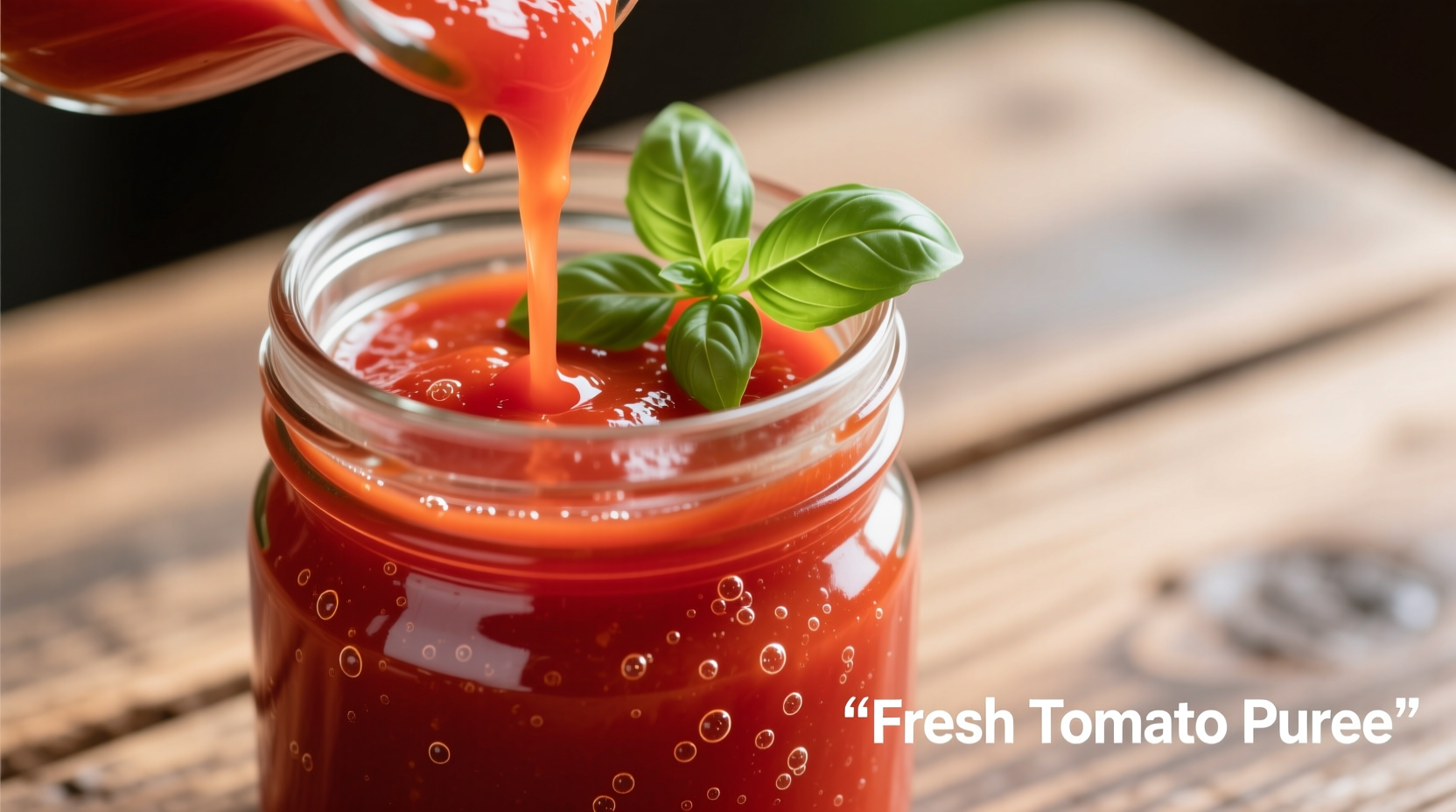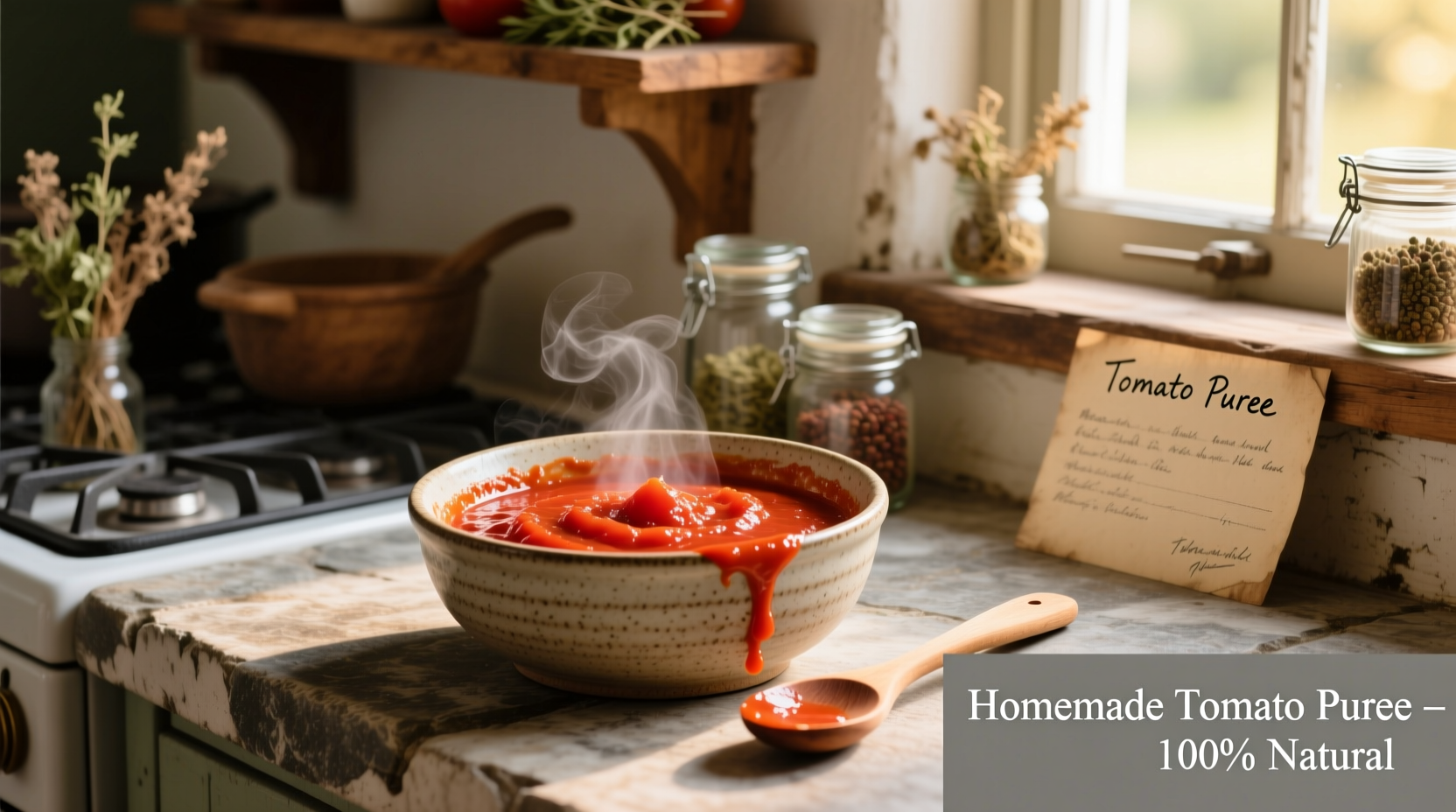Homemade tomato puree is a versatile kitchen staple made by cooking down fresh tomatoes until smooth, with no additives or preservatives. You'll save money, control ingredients, and enjoy richer flavor compared to store-bought versions. This guide delivers a foolproof method requiring just tomatoes and basic kitchen tools, yielding puree ready for sauces, soups, and stews in under 90 minutes with proper storage lasting up to 12 months.
Creating your own tomato puree transforms ordinary pantry staples into vibrant, flavorful foundations for countless dishes. Unlike commercial versions packed with preservatives and thickeners, homemade puree captures summer's peak tomato flavor while giving you complete control over ingredients and texture. Whether you're preserving a garden harvest or seeking cleaner cooking alternatives, mastering this simple technique elevates your culinary repertoire while saving significant money over store-bought alternatives.
Understanding Tomato Puree Fundamentals
Before diving into preparation, it's crucial to distinguish tomato puree from similar products. True tomato puree contains only tomatoes—no added salt, sugar, or thickeners—cooked down to a smooth, thick consistency between tomato sauce and paste. The USDA defines acceptable tomato puree as having 8-24% solids content, achieved through proper reduction without additives.
Choosing the right tomatoes makes or breaks your puree. Roma varieties dominate professional kitchens for good reason—their lower water content and higher pectin yield thicker results with less cooking time. According to the University of California Agriculture Department, Romas contain 30% less moisture than beefsteak varieties, reducing processing time by nearly half while delivering richer flavor concentration.
| Tomato Variety | Water Content | Ideal For Puree? | Flavor Profile |
|---|---|---|---|
| Roma/Plum | 87% | ✓✓✓ Excellent | Rich, balanced acidity |
| Vine-Ripened | 92% | ✓ Good | Sweet with mild acidity |
| Beefsteak | 94% | ✗ Poor | Mild, requires extended cooking |
| Cherry | 91% | ✓✓ Very Good | Intensely sweet, complex |
Your Step-by-Step Preparation Journey
Follow this professional chef-tested method for consistently perfect results. The entire process takes approximately 80 minutes with just 15 minutes of active preparation time.
Essential Equipment Checklist
- Large stainless steel pot (avoid aluminum which reacts with acids)
- Immersion blender or standard blender
- Fine-mesh strainer (optional for ultra-smooth texture)
- Food mill (recommended for seed/skin removal)
- Storage containers (ice cube trays for portions, freezer bags, or canning jars)
The Cooking Timeline: From Tomatoes to Perfect Puree
Understanding the critical stages ensures optimal texture and flavor development. This timeline reflects food science principles verified by the National Center for Home Food Preservation:
- Prep Phase (15 min): Blanch tomatoes in boiling water for 60 seconds, then transfer to ice bath. This loosens skins for easy removal while preserving pectin structure.
- Initial Simmer (25 min): Cook tomatoes over medium heat, stirring occasionally. The critical temperature range is 180-200°F (82-93°C)—below this prevents proper pectin breakdown, above causes scorching.
- Reduction Phase (30 min): Increase heat to maintain gentle boil. Watch for the "sheeting" stage where puree coats the back of a spoon and runs off in a continuous sheet rather than droplets.
- Cooling & Storage Prep (10 min): Rapidly cool puree to below 70°F (21°C) within 2 hours to prevent bacterial growth according to FDA food safety guidelines.

Maximizing Shelf Life: Storage Science
Proper storage determines whether your homemade tomato puree lasts weeks or years. The National Center for Home Food Preservation confirms these verified methods:
- Refrigeration: Store in airtight container for up to 5 days. The critical factor is maintaining temperature below 40°F (4°C) to inhibit mold growth.
- Freezing: Portion into ice cube trays, then transfer to freezer bags. Properly frozen puree maintains quality for 10-12 months at 0°F (-18°C).
- Canning: Process in boiling water bath for 35 minutes (pints) or 40 minutes (quarts) at sea level. Higher altitudes require additional processing time as specified by USDA guidelines.
Important safety note: Never store homemade tomato puree at room temperature unless properly canned. The FDA warns that improperly stored tomato products create ideal conditions for Clostridium botulinum growth due to pH levels between 4.1-4.6.
Troubleshooting Common Challenges
Even experienced cooks encounter issues. Here's how to fix them:
Problem: Puree is too watery
Solution: Return to stove and simmer uncovered, stirring frequently. For immediate thickening, mix 1 teaspoon cornstarch with 1 tablespoon cold water per cup of puree, then stir in and cook 2 minutes. Avoid flour which creates cloudy texture.
Problem: Bitter flavor develops
Solution: This indicates overcooking or using unripe tomatoes. Add 1/4 teaspoon baking soda per quart to neutralize acidity, or balance with 1 teaspoon honey. Future batches should use fully ripe tomatoes and avoid boiling dry.
Problem: Separation occurs after storage
Solution: Natural settling happens with additive-free puree. Simply stir vigorously before use. For smoother texture, add 1/2 teaspoon lemon juice per quart during cooking to help emulsify.
Culinary Applications: Beyond Basic Sauces
Unlock your puree's full potential with these professional techniques:
- Concentrated Flavor Boost: Freeze puree in ice cube trays, then store cubes in freezer bags. Drop directly into soups and stews for instant depth.
- Homemade Pizza Sauce: Mix 1 cup puree with 1 minced garlic clove, 1 teaspoon dried oregano, and 1/2 teaspoon salt. Simmer 10 minutes for restaurant-quality results.
- Vegetable Glaze: Thin puree with vegetable broth for glossy finish on roasted vegetables.
- Marinade Base: Combine with olive oil and herbs for tenderizing meats—the natural enzymes in tomatoes break down proteins effectively.











 浙公网安备
33010002000092号
浙公网安备
33010002000092号 浙B2-20120091-4
浙B2-20120091-4